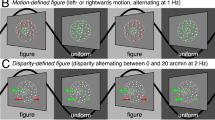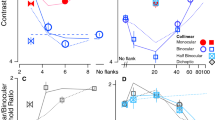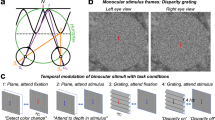Abstract
MODELS of stereopsis typically assume that all the information about stereoscopic depth is contained in the disparity field, that is, the positional differences of image features that arise from surfaces visible to both eyes. But such models have difficulty in resolving image regions containing occlusions, because a portion of the occluded surface is visible to only one of the two eyes ('half-occlusions')1. Here I present displays revealing an unexpected relationship between interocular differences in image position and occluding contours. The partial occlusion of contours can give rise to both horizontal and vertical image differences that are not disparities. The results show that the visual system interprets these image differences as signalling the presence of occluding contours. Even when a single line segment serves as a binocular target, subjective contours form that can appear both oriented and in depth. These local subjective contours have a strong tendency to interact cooperatively and form global contours not present in the monocular images. These and other findings2–4 show that stereoscopic processing actively decomposes vertical and horizontal image differences into disparities and half-occlusions. The two sources of information are complementary: while disparity provides relative depth information about surface features visible to both eyes, half-occlusions provide information to segment the visual world into coherent objects at object boundaries.
This is a preview of subscription content, access via your institution
Access options
Subscribe to this journal
Receive 51 print issues and online access
$199.00 per year
only $3.90 per issue
Buy this article
- Purchase on Springer Link
- Instant access to full article PDF
Prices may be subject to local taxes which are calculated during checkout
Similar content being viewed by others
References
Belhumeur, P. N. & Mumford, D. Proc. Computer Soc. Conf. Computer Vision and Pattern Recognition 506–512 (IEEE Computer Society, Washington DC, 1992).
Nakayama, K. & Shimojo, S. Vision Res. 30, 1811–1825 (1990).
Gillam, B. & Borsting, E. Perception 17, 603–608 (1988).
Anderson, B. L. & Nakayama, K. Psychol. Rev. (in the press).
Julesz, B. Foundations of Cyclopean Perception (Univ. Chicago Press, 1971).
Marr, D. Vision (Freeman, San Francisco, 1982).
Mayhew, J. E. W. & Longuet-Higgens, H. C. Nature 297, 376–378 (1982).
Cumming, B. G., Johnston, E. B. & Parker, A. J. Nature 349, 411–413 (1991).
Rogers, B. J. & Bradshaw, M. F. Nature 361, 253–255 (1993).
Ogle, K. N. Binocular Vision (Saunders, Philadelphia, 1950).
Lawson, R. B. & Gulick, W. L. Vision Res. 7, 271–297 (1967).
Pollard, S. B., Mayhew, J. E. W. & Frisby, J. P. Perception 14, 449–470 (1985).
Grossberg, S. Percept. Psychophys. 41 (2), 117–158 (1987).
Author information
Authors and Affiliations
Rights and permissions
About this article
Cite this article
Anderson, B. The role of partial occlusion in stereopsis. Nature 367, 365–368 (1994). https://doi.org/10.1038/367365a0
Received:
Accepted:
Issue Date:
DOI: https://doi.org/10.1038/367365a0
This article is cited by
-
Binocular Energy Estimation Based on Properties of the Human Visual System
Cognitive Computation (2013)
-
Putting plaids in perspective
Nature (1999)
-
Stereoscopic occlusion junctions
Nature Neuroscience (1999)
Comments
By submitting a comment you agree to abide by our Terms and Community Guidelines. If you find something abusive or that does not comply with our terms or guidelines please flag it as inappropriate.



